The actions against Provera (15th January)
However, Augereau, positioned in the
Lower Adige area, failed to block Provera's
path. He had been kept busy by Bajalich's feint
attacks before he realised Provera's real
intention. Even then he didn't move to pursue
Provera until after first attacking the force left
to protect Provera's pontoon bridge over the
Adige, said to be 2,000 troops and 14 guns. He
defeated them and destroyed the bridge. He then
gave chase and, although he caught up with
Provera's rearguard and caused them heavy
casualties, he was unable to prevent him
reaching Mantua.
In the days that followed Joubert pushed Alvinci back until the French were able to take up a position at Lavis; a position lost by Vaubois before the Battle of Arcola. Massena was at Bassano and Augereau's Division marched to Treviso at the southern end of the Piave River. (It appears Augereau was sent back to Paris to show off the captured flags and standards and General Jean Joseph Guveux (or Guieu) was now in charge of his troops). Serurier continued
besieging Mantua, while Rey, with 4,000 troops
as a guard, marched the Austrian prisoners back
to France.
The Fall of Mantua
Wurmser now realised there was no chance of holding Mantua or of being relieved. So, on the 2nd of February, 1797, he surrendered. It was reported that during the siege the Austrians had lost 18,000 troops due to sickness, along with 6,000 civilians. The same diseases had caused the French about 7,000 casualties. Wurmser was given full honours for such a stubborn defence. Serurier accepted the surrender on behalf of Napoleon, who, although he had great respect for the old campaigner, could not take it because he was marching south with Victor and 9,000 troops to sort out the Pope. The Papal forces were defeated at Senio and the Pope asked for an armistice, which resulted in the Treaty of Tolentino.
The Battle of Rivoli had been won by the
marching and fighting powers of the French
revolutionary soldiers who had fought and
marched almost non-stop for four days and
nights. (One might also add their climbing
powers considering the tenain.) Even so, they
still couldn't have achieved it without the skill
of their 'gambler' commander, who was willing
to take risks when needed.
They were also
helped in their victory by the poor command of
their opponents. The Austrian troops
themselves were just as tough and capable as the
French but had no one in command to exploit
any gains they made. After Rivoli it appeared
that Napoleon Bonaparte and his ragtag army
had finally won Italy, for a while anyway. To
keep it Napoleon knew he had to
invade Austria and defeat the Austrians totally,
which, eventually, he would do. But that, as the
saying goes, is another story, and, I might add,
another visit.
The Site Today: (and Monuments and Museums)
My first attempt to reach Rivoli was
via boat from Desenzano to Garda on the
eastern side, and then by local bus to Caprino. I
went with my wife and my youngest son, aged
7. It was late in the year and finding suitable
public transport was a constant problem and it
took quite some time to get there.
Unfortunately, due to this we had virtually
no time left to look over the place. This was because we discovered that the bus we arrived on
was also the last bus back.
Considering how easy
it is to get lost in the area, the heat of the day,
being in the mountains and how the roads seem
to go on forever, and that we would probably
have to climb the Trombalore Heights to reach
Rivoli, we decided to call it a day. Mainly
because there was no guarantee that we' d find
transport at Rivoli, or anywhere else for that
matter, so back to Lake Garda we went.
I took some photos of Caprino and The Trombalore Heights but again, as at Castiglione and Arcola, I had used a faulty film so there was nothing to show for our efforts.
On my second attempt I went alone.
This time I travelled from Desenzano to
Verona by bus in the hope of getting another
bus direct to Rivoli. I should have known better.
However, I did get one as far as Affi. From
there I thought I could walk to Rivoli and worry
about the journey back later. I was wrong again.
I kept getting lost, even though I was pointed
in the direction of Rivoli several times by the
usual friendly locals. In the end, tired and
very hot, I staggered into a garage and asked
them to call me a taxi. This time I was lucky.
The last taxi was about to finish for the day but
agreed to go to Rivoli, that is, after I suggested
he could take me back to Verona afterwards.
As it turned out the taxi driver was
brilliant. He couldn't understand a word of
English but he knew the area well. I mentioned
Napoleon and he took me to the Napoleonic
museum in Rivoli. It looked about the size of a
small house but unfortunately, being so late in
the year, it was closed. If Arcola is anything to
go by, I should imagine an advance phone
call would be required first. I mentioned
Napoleon again and he drove into a vineyard!
As we drove along the rows of vines with
the hanging bunches of grapes bumping against
the top of the taxi, I saw signs in English only,
saying private - keep out! Then he stopped in
the middle of the vineyard and invited me to
sample some of the grapes, which I did, if not a
little apprehensively, I was half-expecting the
local Mafia to appear or the sound of a shotgun
going off at any minute, and I was seriously
beginning to wonder if the heat had begun to
affect the driver. I thought later the truth was
probably that either he or a close relative, must
have owned the vineyard.
Re-enactment Potential
I could see several venues where a
good re-enactment could take place, given
permission that is. For example, a march could
be made with little difficulty (what's a few hours
walking for dedicated re-enactors?) by both
French and Austrian units from Caprino to the
Trombalore Heights. Here, various actions could
be fought with either the Austrians attacking
the heights held by French units, or the French
attacking the retreating Austrians fighting a
rearguard. Apart from the roads running along
both sides of the Adige, used by Quasdanovich
and Wukassovich, and the Rivoli plateau, the
area is very mountainous.
However, there are several areas, including Monte Baldo, where large scale
skirmish actions could take place.
Getting There
As already mentioned I travelled by
boat from Desenzano to Garda on the east side
of Lake Garda, and then via local bus to
Caprino. This would be a good place to begin
visiting the battle site although it would mean
walking to the Trombalore Heights and then
climbing them to reach Rivoli, something I
wouldn't suggest on a hot day.
By car you could travel north from Verona towards Rivoli along the N12 until you reach Dolce. However, this would also mean that you would be stuck on the eastern bank of the Adige.
A crossing place south of Dolce, appears on the map, as does one north of Dolce at Rivalta. However, be warned, I couldn't see any crossing places in the area at all. Alternatively, you could travel west from Verona along Road Number 11 until you reach the A22, and then north along the A22 until you reach the turn off for Rivoli.
Whether you're bussing, walking or
travelling by car it's important if not vital that
you take plenty to drink and some good maps.
Maps are difficult to come by, especially
detailed ones, but I was kindly provided with the
following map free of charge by The Italian
Tourist board: KOMPASS Carta turistica No
102. Lago di Garda Monte Baldo. 1:50,000.
Wargaming
Alternatively, the battle could be
divided into parts for either a solo game, or for
a series of games played by different players.
Rivoli is ideal as a solo game because it has one
side defending and the other attacking. This
game could consist of the French defence of
the Trombalore Heights alone or be combined
with the action in the Osteria Gorge. However,
for a multi-player game the battle could be
divided into separate actions on separate tables.
One game could consist of the fight in the
Osteria Gorge. Another could be the battle for
the Trombalore Heights, combined possibly
with the action at San Marco Chapel, while a
third could be the fighting involving Lusignan's
column at Affi and Monte Pipalo.
It must be noted however that Lusignan had
no idea of what was happening to the other
Austrian columns during the battle, and this fact
must be included into the game.
The battle does appear, in many places, to be more of a combat between the best
mountain climbers. My respect for the men
who fought on both sides grew considerably
after my visit. How they marched, climbed and
then fought each other, I'll never know. Most
of the fighting seemed to involve mainly the
infantry and artillery, although cavalry did
come into action on two definite occasions: one
when the French cavalry, including the 1st
Heavy Cavalry regiment, was sent against the
Austrian dragoons as they charged up the
Osteria Gorge. Another when the French light
cavalry charged the attacking Austrian infantry
on the Trombalore Heights.
In my game, history virtually repeated
itself. The French, after some tough fighting,
lost San Marco Chapel and were also driven out
of Osteria village by the heavy artillery fire
from Wukassovich's guns. The Austrians then
advanced up the Osteria Gorge and things were
beginning to look bad for the French who were
finding it hard to hold onto the Tromhalore
Heights. Then Rey's Division arrived and after
some severe fighting the Austrians were finally
routed.
Unfortunately, unlike reality, Lusignan's column arrived too late to have any
effect, didn't reach Monte Pipalo and was forced
to surrender. I found it a very enjoyable game
and I wasn't at all sure how it was going to end.
Playing the game also helped me understand and
appreciate Napoleon's skill of overcoming the
problem of being outnumbered. He took a risk,
moved and placed his troops in the right place
at the right time to obtain an incredible victory.
On the page it sounds so easy but playing it was
another matter and I found it tough going. It
would interesting to know if other wargamers,
taking up the French side, could overcome the
same problems. Likewise, would those taking
the Austrian side, unlike the real Austrian
commanders, manage to use their numerical
superiority to effect before the French
reinforcements arrived?
Conclusion
As I've already mentioned, researching
the battles of Castiglione, Arcola and Rivoli,
proved very interesting but also very
frustrating. Sadly, there is a general lack of
detailed information concerning the Orders of
Battle, and many accounts appeared to he based
mainly on the French point of view, probably
because they won the battles. However, my
research uncovered the fact that there are many
more books written in German and French,
which, to my knowledge have yet to be
translated.
The Italian campaigns are screaming out to be studied in far more detail than I was
able to do, considering my limitations of time and finance. And I'm sure a researcher, or team of researchers, who could speak and read German, French and Italian, and who could travel to Italy, Austria and France, would surely uncover far more than I did. But, I suppose I'll have to win the lottery to fund such an idea. Anyway, I can assure you that it's an area well worth looking at for anyone interested in the Revolutionary and Napoleonic period.
Sources List: Books, Magazines, Museums, and Other
Related
Back to Table of Contents -- First Empire 26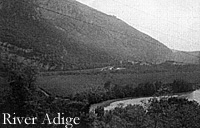 While Joubert and Rey were busy pursuing
Alvinci, Napoleon had set off to deal with Provera, who had crossed the Adige on the 13th at Anghiari just north of Legnago, and was now heading for Mantua with 7,000 men. Napoleon took with him Massena's cavalry and two Demi-Brigades, the strongest being left with Joubert and Rey. (He may have also picked up Victor's command on
the way since some accounts indicate that
Victor was approaching the battlefield behind
Rey).
While Joubert and Rey were busy pursuing
Alvinci, Napoleon had set off to deal with Provera, who had crossed the Adige on the 13th at Anghiari just north of Legnago, and was now heading for Mantua with 7,000 men. Napoleon took with him Massena's cavalry and two Demi-Brigades, the strongest being left with Joubert and Rey. (He may have also picked up Victor's command on
the way since some accounts indicate that
Victor was approaching the battlefield behind
Rey).
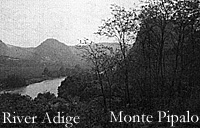 Unfortunately for Provera,
luck again wasn't on the side of the Austrians.
After several attacks he still failed to break
though the French troops besieging the fortress.
Also, a plan in which Wurmser would sortie out
and attack La Favorite while Provera
attacked the French troops at Fort St. George,
after some initial success, also failed. The
French columns pursuing him were now arriving and Provera was forced to surrender what
was left of his shattered command on the 16th.
Bajalich retreated back to Bassano where, on
the 24th, he was caught between two columns,
and, after suffering heavy casualties, retreated
north in disorder.
Unfortunately for Provera,
luck again wasn't on the side of the Austrians.
After several attacks he still failed to break
though the French troops besieging the fortress.
Also, a plan in which Wurmser would sortie out
and attack La Favorite while Provera
attacked the French troops at Fort St. George,
after some initial success, also failed. The
French columns pursuing him were now arriving and Provera was forced to surrender what
was left of his shattered command on the 16th.
Bajalich retreated back to Bassano where, on
the 24th, he was caught between two columns,
and, after suffering heavy casualties, retreated
north in disorder.
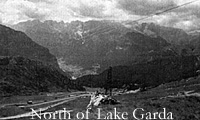 The Rivoli battlefield is too big to visit in one day. Even by car I think you'd need
to plan your routes carefully to make sure you've enough time to have a decent look
around. The site today is covered in vineyards, toll roads, rivers and factories, and, like
Castiglione and to a lesser extent, Arcola, are showing signs of growth in terms of more
industry and new housing. But there are some untouched areas and it's a great place to visit,
not just for seeing the battlefield itself, but also
for the spectacular scenery in the area and the
numerous old buildings, all of which are well
worth visiting, if you have the time.
The Rivoli battlefield is too big to visit in one day. Even by car I think you'd need
to plan your routes carefully to make sure you've enough time to have a decent look
around. The site today is covered in vineyards, toll roads, rivers and factories, and, like
Castiglione and to a lesser extent, Arcola, are showing signs of growth in terms of more
industry and new housing. But there are some untouched areas and it's a great place to visit,
not just for seeing the battlefield itself, but also
for the spectacular scenery in the area and the
numerous old buildings, all of which are well
worth visiting, if you have the time.
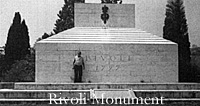 Anyway, we got back in the taxi and drove
on and a few minutes later he turned around a
hedge and we came face to face with the Rivoli
monument. It was bigger than I thought and the
views of the battlefield from it were
breathtaking. I honestly don't think I'd have
found it on foot, even though it's marked
clearly on the map. I'm not sure but I think he
said he had or was going to bring his
bambinos here. Anyway, it brought a
nice ending to the day and this time the film in
my camera worked.
Anyway, we got back in the taxi and drove
on and a few minutes later he turned around a
hedge and we came face to face with the Rivoli
monument. It was bigger than I thought and the
views of the battlefield from it were
breathtaking. I honestly don't think I'd have
found it on foot, even though it's marked
clearly on the map. I'm not sure but I think he
said he had or was going to bring his
bambinos here. Anyway, it brought a
nice ending to the day and this time the film in
my camera worked.
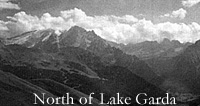 Alternatively you
could travel by bus to Verona and then change
for Affi and walk to Rivoli. Again, not
recommended on a hot day but you might also
be able to catch a bus direct to Rivoli during the
peak summer season.
Alternatively you
could travel by bus to Verona and then change
for Affi and walk to Rivoli. Again, not
recommended on a hot day but you might also
be able to catch a bus direct to Rivoli during the
peak summer season.
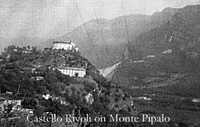 The battle sits is probably too large to
wargame as a whole if you're a purist and want
to play to an accurate scale. However, a
'representative' battle could be played; a game
with a 'Rivoli' flavour. That is, a game in which
we have the Adige River, the Osteria
Gorge, the Trombalore Heights, San Marco
Chapel, Monte Pipalo, and the various villages;
although in my game I only used those of
Rivoli, Osteria, Caprino and Affi. It may not be
realistic but it does offer the same problems of
combat as the real battle, although of course, as
already mentioned, not on an accurate scale.
The battle sits is probably too large to
wargame as a whole if you're a purist and want
to play to an accurate scale. However, a
'representative' battle could be played; a game
with a 'Rivoli' flavour. That is, a game in which
we have the Adige River, the Osteria
Gorge, the Trombalore Heights, San Marco
Chapel, Monte Pipalo, and the various villages;
although in my game I only used those of
Rivoli, Osteria, Caprino and Affi. It may not be
realistic but it does offer the same problems of
combat as the real battle, although of course, as
already mentioned, not on an accurate scale.
Orders of Battle (14th January, 1797)
Back to First Empire List of Issues
Back to MagWeb Master Magazine List
© Copyright 1996 by First Empire.
This article appears in MagWeb (Magazine Web) on the Internet World Wide Web.
Other military history articles and gaming articles are available at http://www.magweb.com